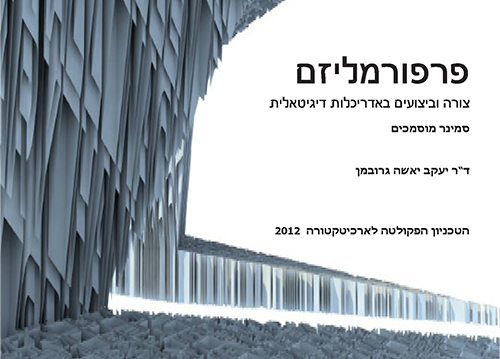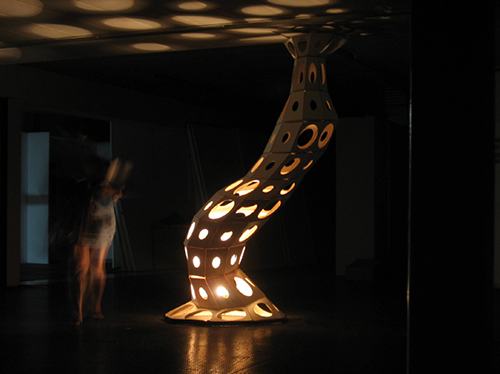The BIM studio
Examining the potential and limitations of employing BIM and parametric design tools in the early stages of the architectural design process – thematic studio (2015). Undergraduate design studio – The studio examines the potential and limitations in using BIM (Revit) in combination with parametric tools (Dynamo) in an architectural design process of a sustainable community center. The projects suggest new interpretations to an urban community center in Tel Aviv for various communities from different age/education and economical backgrounds. The studio examined various types of building programs and organisations and its effect on the building’s performance (both environmental and social). The examination is based on the use of both design and simulation digital tools that are integrated or communicate with BIM tools.
To download the course’s syllabus, research and projects’ book (English/Hebrew, 1100 pages, 310mb) click here: studio book-2015
Growing a Tower
Building a case for a sustainable high density building – thematic studio (2014). Undergraduate design studio – The studio tries to propose an alternative to the single purpose luxury office or residential towers in the cities venter. It is based on the understanding that a shift to high density buildings is necessity in countries such as Israel in which available ground for building is extremely rare and expensive. Moreover, it is already clear that high density buildings are substantially more sustainable from other building typologies (when environmental, social and economical aspects are taken into account). The studio will examine various types of building organisation of high density buildings and its effect on the building’s sustainability. The examination will be based on the use of both design and simulation digital tools.
To download the course’s syllabus, research and projects’ book (English/Hebrew, 877 pages, 160mb) click here: studio book-2014
Observation, Representation and Modelling – Introduction to Computation in Architecture (2013). Undergraduate course – The course reviews the history, basic concepts, contemporary state of the practice technologies and methods in computer aided design, design representation and fabrication. The course includes lectures and hands-on design and fabrication assignments.
To download the course syllabus (Hebrew) click here: Observation, Representation and Modelling-2013
Cellular buildings – thematic studio (2012, 2013). Undergraduate design studio – The studio examines the possibility to implement the new cellular approach to building envelopes, one that is based on a synergy between technology, state of the practice materials and learning from nature. Its aim is to develop a design that examines the ramification of the idea of cellular building envelopes presented earlier in the research section.
To download the studio book 2012 (English and Hebrew) click here: Studio book 2012
To download the studio book 2013 (English and Hebrew) click here: Studio book 2013
To download the course syllabus (Hebrew) click here: studio brief-2013
Computer aided manufacturing (2011, 2012, 2013). Graduate course – The possibility to integrate computers in the fabrication process of architectural elements has significant implications on the way buildings are currently being designed and built. The course presents and teaches new methods to employ computer aided fabrication in architecture. The course introduces contemporary fabrication technologies, methods and ideas in architecture and other disciplines. Students are involved in hands-on design and fabrication assignments in which computer based fabrication machines and software are used. These assignments produce 1:1 models that critically examine contemporary fabrication methods and ideas and try to suggest new ways to employ these tools in architectural design.
To download the course syllabus (Hebrew) click here: cam-10-2012
Parametric design methods (2012 ,2013). Graduate course – Parametric design deals with the generation and modification of architectural form by manipulating the parameters on which its geometry is built. Recent acceleration in the development of computer-based design and manufacturing tools, and above all the advent of parametric design software such as Grasshopper and Paracloud Gem has promoted parametric design to be one of the leading discourses in contemporary architecture design. The course is divided into two complementary parts. The first, practical, part introduces students to parametric design methods and tools. The second part critically examines contemporary discourse on parametric design and the disciplinary and interdisciplinary implications of using these ideas and design methods. The examination is based on the analysis of seminal texts and precedents.
To download the course syllabus (Hebrew) click here: parametric design 2013-72dpi
Performalism – the connection between form and function within contemporary discourse in digital architecture (2012,2013). Graduate seminar – Using computer for form generation, simulation and manufacturing raises questions regarding the meaning and relevance of modernist-based concepts such as performance, standard, mass-construction, module and grid. Computer-based design is not limited to constraints of Euclidian geometry. It offers new design possibilities that raise the level of information (geometric and performance information) which is used to create the architectural form. The seminar presents and discusses various aspects of the shift to computer-based design. It also examines leading concepts and theories in computer-based design creation, representation and manufacturing.
To download the course syllabus (Hebrew) click here: performalism-2012
Advanced Building Information Modeling (BIM) (2012,2013) – Design and construction of modern buildings requires not only professional skills, but also the ability to collaborate in multi-disciplinary teams and knowledge of and proficiency in the use of sophisticated information technologies. Building Information Modeling (BIM) tools are essential for design, for engineering and management analyses of various kinds, and for communication and management.
In this course students learn advanced concepts of Building Information Modeling through formal lectures, but they also have the opportunity, through hands-on group projects, to apply the theoretical knowledge to development of a building project, ranging from conceptual design, through engineering and cost analyses, to detailed design and fabrication of models using rapid prototyping technology.
On completion of the course students have a good understanding of the capabilities and the limitations of BIM technology. They also gain first-hand experience of the ways in which BIM can be used to support professional and multi-disciplinary teamwork, and become competent in operation of a fairly broad set of tools appropriate for their particular profession. Students gain a detailed understanding of the ways in which other professions in the architecture, engineering and construction domains use BIM. The course is a joint offering of the Faculty of Architecture and Faculty of Civil and Environmental Engineering (in collaboration with Prof. Rafael Sacks from the Structural Engineering and Construction Management Unit).
To download the course syllabus (Hebrew) click here: BIM Graduate Course – final
Final project D_cology studio (2011-12). Undergraduate final design studio – the studio was grounded on an initial hypothesis that development in cities has to be performed from within, and not through extending city limits outwards. Based on this assumption the studio located urban “brownfields” in which extreme conditions had previously prevented development. The studio suggested architectural approaches to develop design and building projects in these urban brown fields.
To download the course syllabus (Hebrew) click here: syllabus 2010-11



